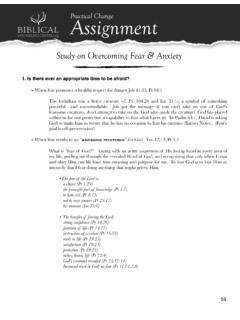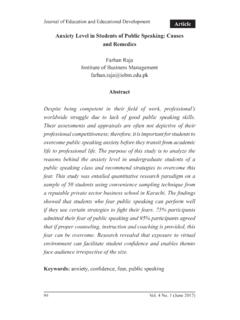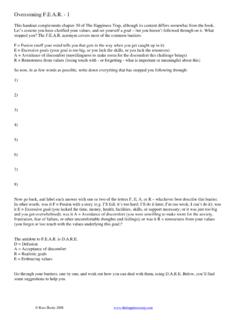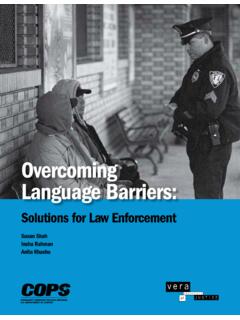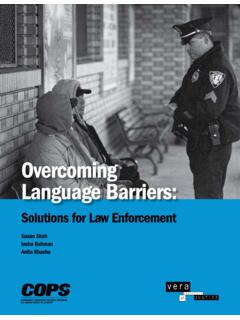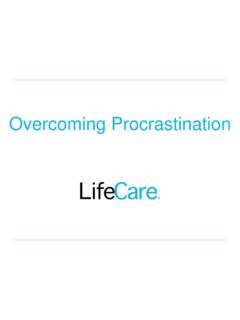Transcription of Patient Handout for Overcoming Driving Fear and Avoidance
1 Patient Handout for Overcoming Driving Fear and Avoidance1 Koch, , ABPP What is Driving Fear? A specific phobia of Driving requires that you either avoid Driving or riding as a passenger because of fear, or that you tolerate Driving or riding with high levels of anxiety and fear. Driving fear is not just fear of getting behind the wheel and operating a car. It can also involve fear while riding as a passenger. In fact, some Driving fearful people are more afraid of riding as a passenger than they are of Driving , per se. Not all people with Driving fear have much in the way of observable Avoidance of Driving , although many patients gradually become aware of subtle Avoidance habits they have developed. Many people with Driving fears get where they have to go, but suffer a great deal of distress while in a car. They arrive at work in a bad mood or with a tension headache because of excessive tension while Driving , or they have multiple scares whenever in a car so that their Driving experience is quite upsetting.
2 They may also restrict their actual Driving or riding to only those necessary trips, which results in reduced social and recreational activities. Alternatively, they may alter their commuting routes in a manner that restricts their freedom of movement. Why is Driving Fear a Problem? Some people may think that Driving fears are pretty trivial or that they are so common that they don t merit treatment. It is true that some people may be able to lead a life with even a severe Driving fear and not suffer many losses because of this fear. However, this depends on the individual s lifestyle, work and family life, and personal goals. For example, the writer (Bill) has a mild fear of heights. This has never been a big problem to him because he has never been a downhill skier, the fear is mild enough that he doesn t mind looking out of high rise windows, and he has no other recreations that require him to stare down from high places.
3 What would happen, however, if Bill had to ski to work every day, or if Bill had fallen in love with a partner whose main recreational interests were downhill skiing and climbing mountains? Luckily for Bill, there are no mountains between his home and his office. Unluckily for Driving fearful people, most of us live in society where transportation in automobiles is increasingly necessary and our roads in urban centers are becoming even more crowded. Necessary Treatment Activities to Overcome Driving Fear Your therapist will help you with the activities described below, but you need to understand that success in Overcoming Driving fear will depend on you practicing new (or forgotten) skills. To get better, you will need to a. drive and ride as a passenger much more frequently and for prolonged periods of time b. focus more on other drivers good Driving behaviour and courtesy and less on close calls or other drivers mistakes 1 Copyright 2003 Koch, c.
4 Learn about, and subsequently, suppress your own safety compulsions , those habits you have developed to make yourself feel safer in a car, but which likely maintain your fear in the long run d. identify and alter beliefs and automatic thoughts that make you feel more at risk in a car Getting Started - Setting mobility goals. Just like learning any new skill, Overcoming fears requires that you set specific goals for what you want to accomplish. Failure to set concrete, specific goals is frequently one of the obstacles fearful drivers have in Overcoming their fear. You need to think about how much you would want to drive IF you didn t have this Driving phobia. Where would you travel, who would you visit on a regular basis, what recreational outings would you take? We would like you to start out in a really concrete manner and purchase a map of the local metropolitan area. Then highlight those areas where youcan currently drive or ride as a passenger without significant discomfort, and then highlight in a different colour where you would want to travel if you did not have this phobia.
5 If you are not very avoidant, but merely feel a lot of tension, anxiety and/or fear while Driving , then change this assignment to highlighting (a) those areas you can drive without tension/anxiety/fear and (b) those areas where you experience problematic tension, etc. Without some kind of mobility goals, this part of treatment will stall because you will see little objective change in your lifestyle. Having done this, you now know the difference between how you are and how you would like to be. Keep this map because you will be using it every week. - Identifying Traffic Cues that Precipitate Fear or Anxiety Driving fear is not just being fearful when you are behind the wheel. If it were, you wouldn t be able to even sit in the driver s seat in an automobile showroom. No, Driving fear relates to specific events, objects, or conditions that you run across while traveling in a car. The cues that make you feel more anxious might be general conditions like rain, darkness, slick roadways.
6 Alternatively, the cues may be isolated events like other cars merging into your lane, being passed by large trucks or buses, pedestrians crossing in front of you. Or particular Driving situations may induce fear, such as intersections, highway merge lanes, left turn lanes, Driving in the left lane with oncoming traffic, or heavy traffic. You need to carefully identify the cues that make you feel more tense, anxious, or fearful so that you can practice naturalistic exposure to these cues. You can identify such situations by keeping track of where you feel tense, anxious or fearful during your next few drives. Use the table below to record on. Name:_____ Date:_____ Driving Situation, Condition, or Event Tension, Anxiety, or Fear Rating Rate each situation on a 0 100 pint scale, where 0 is as calm as you have EVER been, and 100 is EXTREMELY tense, anxious or fearful - Assessing your Avoidance habits and safety compulsions.
7 Behavioural Avoidance and maladaptive anxiety-reducing safety behaviours are common in Driving fear. These behaviours can be roughly broken down into 3 categories: (a) behaviours intended to protect yourself from harm if you are in an collision, (b) behaviours intended to make yourself feel safer, and (c) behaviours intended to reduce your feeling that you might lose control. These problematic habits can interfere with the reduction of fear and anxiety while Driving or riding as a passenger. A few examples will suffice: a. Safety compulsions. Grasping door handles, seats, bracing oneself against the dashboard or floorboards, back seat Driving , traffic vigilance while riding as a passenger, closing one s eyes while riding as a passenger are common behaviours in MVA-PTSD and Accident Phobic patients. While the intent of these habits is generally to reduce the probability of a future accident or of injury during a potential accident, they likely serve a short-term anxiety-reducing effect that makes you increasingly dependent on the compulsion in future.
8 Successful treatment requires the blocking of such behaviours during in vivo exposure assignments. Please take the checklist below with you on your next few passenger rides and note what safety compulsions you have. Use the comments section to describe this in more detail. Safety Compulsions as Passenger Do I Do This? Yes/No Comments back seat drive Grab door handles Grab seat Grab dashboard Step down on imaginary brakes on my side of car Grab something else for safety Scan traffic vigilantly for possible threats warn the driver Close eyes Other (describe) b. Avoidance behaviours. Do you avoid whenever possible the centre lanes of 4 lane streets or highways? Do you avoid Driving at particular times of day or on particular streets? Do you avoid Driving at times because you think you might get flustered and cause an accident yourself?
9 These are examples of specific Avoidance strategies that other Driving phobics use to avoid feeling anxious. To overcome this fear, you will have to identify your own Avoidance behaviours and then plan outings or other Driving experiences that give you confidence in these situations. What do you avoid? Take some time at home to think of what Driving situations/places you avoid and write them down below. Driving Situations/Places I Avoid Comments c. Distraction by music or talking with others when in a car are frequently cited as ways to cope with aversive anxiety by previously traumatized individuals. This is a subtle method of Avoidance . You should check yourself when in a car to see if you do something like this to reduce your fear. d. Alcohol, marijuana and/or prescription drug sedation is another Avoidance strategy that has a number of negative consequences.
10 Do you use minor tranquillizers to calm yourself before, during or after Driving ? Implementing Naturalistic Exposure to Driving Situations - Purposes of naturalistic exposure a. to allow fear to naturally reduce as you become more accustomed to being back in the situation and have repeated experiences of being safe. The more frequent and longer your exposures to feared situations are, the more rapidly you will come to feel safe b. To allow you to regain confidence in your Driving ability or ability to cope in the situation c. To test any beliefs you have about the likelihood of being in an accident. - Obstacles to In Vivo Exposure a. Some Driving phobics try to fit their naturalistic exposure sessions into their usual work commute or errands. These particular drives, however, are often insufficiently long to allow anxiety/fear to reduce noticeably. As well, most Driving phobics have usually established routes that bring them into contact with as few fear-eliciting stimuli as possible ( , high traffic areas, merging lanes, busy intersections).
